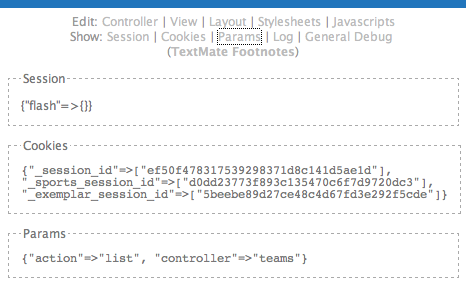Textmate Footnotes
For a while now I’ve been using Duane Johnson’s TextMate Footnotes plugin with my Rails development. It’s been the biggest boost to my productivity since I started using Rails. I kind of assumed that most Rails developers were using it, but apparently it’s not as widely known as it should be.
I first learned about footnotes from Geoff Grosenbach, when he interviewed me last year for the Ruby on Rails Podcast. Geoff mentioned that it links lines from a Rails stack trace (displayed in the browser in development mode) so that clicking will open the appropriate file in TextMate, positioned to the correct line. Nice!
But it does more than that. When there is no error and your page renders correctly, the plugin adds “footnotes” to it: a little div at the bottom of the page with useful features for development and diagnosis:
You can show the contents of the current session, current cookies, the parameters passed to the controller, and the last 200 lines of the Rails log. But the most useful things are the links that ask TextMate to open the controller, view, layout, and other important files that Rails used to build that page. (It only does all this when the app is running in development mode, of course.)
If you’re doing Rails development on OS X, install it this way:
$ script/plugin install -x http://macromates.com/svn/Bundles/trunk/Bundles/Rails.tmbundle/Support/plugins/footnotes
If you aren’t on OS X, I know there are ways to define URL schemes like the “txmt” scheme TextMate defines on OS X. What are you waiting for? Arrange for “txmt:” URLs to open your favorite editor appropriately, install footnotes, modify it (to remove the “only on OS X” code), and have fun!

